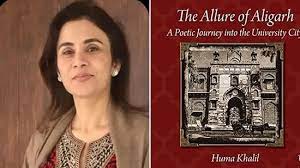INDIA :
The Allure of Aligarh: A Poetic Journey into the University City, authored by Huma Khalil, mesmerizes through the poetry it holds within its covers and the beautiful visuals it carries.

Book – The Allure of Aligarh: A Poetic Journey into the University City
Author – Huma Khalil
Publishing House – Hay House Publishers India in collaboration with Rekhta Foundation
The title of the book allured me even before I could hold the book in my hands. Although I have never studied in Aligarh, my grandfather was a professor in the Department of English, in the 1940s and 50s and hence I have grown up hearing fascinating stories about this university town, and a fondness has grown over the years. The subtitle of the book, A Poetic Journey into the University City puts this gorgeous coffee table book in perspective.
aa.ii gulshan me.n na tere, bhuul kar fasl-e KHizaa.n
terii sarhad me.n rahaa, har ilm-o-daanish ka samaa.n
These are the opening lines of the Introduction, translated as:
(The crop of autumnal decline never reached your vale
All intellect and wisdom did in your realm prevail)
The author, Huma Khalil, who has earlier translated the seminal work of her father, the well-known poet, Khalil Ur Rahman Azmi, Urdu Mein Taraqqui Pasand Adabi Tehreek as Many Summers Apart: Gems from Contemporary Urdu Literature, has put this endeavor together where a city is explored through the prism of Urdu poetry. At the very outset, she points:
Aligarh’s fiza (ambience) has always been infused with sher-o-shayari, and its landscape is conducive to literary creativity. Each poet depicted campus life during his or her stay there, and these observations spanned the city’s various facets.
This pictorial book covers different sections, exploring them through a poetic landscape. It begins with discovering the history of this Shahr-e-Tarab (The City of Joy) as it mentions how the eminent poet, Majaz had given it this title in 1935, mentioning the important monuments. The next section is on the conception of the Muhammadan Anglo-Oriental College to finally the realization of Aligarh Muslim University tracing the coming up of the different buildings on the campus, with elaborate mentions of people like Henry George Impey Siddons, Theodore Beck, Sir Walter Raleigh, Harold Cox and their contribution in shaping AMU in its initial days. Khalil quotes Akbar Allahabadi what he wrote on the demise of Beck:
afsos hai ki mar ga.e beck, ab nahii.n ko.ii
is darja jis me.n ilm ho, is darja hilm ho
(Alas that Beck has died, now there is no one left
Who has so much knowledge and so much gentleness)
The following section covers the contribution of Sir Syed Ahmed Khan, the visionary who in fact immortalized the city, going into the details of his efforts and how the university was actually established. It also gives a peek into the establishment of the Women’s College, the efforts of Sheikh Abdullah, fondly known as Papa Mian, and his wife, Waheed Jahan Begum.
The section on George Peuch ‘Shor’, the first known Urdu poet of the city opens the relation that Aligarh had with Europe. The book also covers in detail the satirical verses of Akbar Allahabadi, mocking Sir Syed’s efforts to raise funds for the university. He pens:
ab kahaa.n tak but-khade me.n sarf-e-imaa.n kiijiye
taa-kujaa ishq-e-butaa.n me.n sust paimaa.n kiijiye
hai yahii behtar Aligarh jaa ke sayyad se kahuu.n
mujh se chanda lijiye mujh ko musalmaa.n kijiye
uljha hua hai chanda o iskuul me.n har ek
(How far in house of idols, my faith must I defray?
How far in love of idols, obeisance should I pay?
It is better to go to Aligarh and to Syed say,
Take these alms from me and make a Muslim of me, pray
Each one is entangled in school and alms today)
The book continues to dip into the oeuvre of other poets like Altaf Hussain Hali and Majaz, poets who have had interesting associations with the city, and hence have written at length about it.
The next part of the book delves into cultural aspects which are forever etched in the minds of an Aligarian – the numaish, the tehzeeb and the riwayat.
Khalil begins this section quoting Farhat Ehsaas,
us se milne ki koi surat nikalti na thi
aur tabhi dil ke Aligarh ki numaish aa gayi
(There was no way to meet her that one could contrive
And just then hearts’s Aligarh’s numaish did arrive)
The last chapter of the book is a postscript by the celebrated filmmaker, Muzzafar Ali, who traces his journey and influences at AMU.
One comes across various other books on cities, like City Adrift: A Short Biography of Bombay by Naresh Fernandes, Esther David’s Ahmedabad: City with a Past or the very recent, A for Prayagraj: A Short Biography of Allahabad by Udbhav Agarwal among others. Then there are some interesting coffee table books too, like Raghu Rai’s books on Delhi and Amritsar and Calcutta Then, Kolkata Now by Sunanda K Dutta and Indrajit Hazra. But the point where The Allure of Aligarh stands apart is through the poetry it holds within its covers, along with it being a visual treat; the archival photographs in sepia, fills one with the desire to revisit Aligarh. As Majaz is quoted in the book,
Aa aa ke hazaaron baar yahan hud aag bhi hum ne lagai hai
Phir saare jahan ne dekha hai ye aag humeen ne bujhai hai
(Coming here a thousand times, these fires we roused,
And then the world entire saw, these we ourselves then doused.)
(Saba Mahmood Bashir is an author, poet and translator and an Assistant Professor in the Department of English, Jamia Millia Islamia; views expressed in this article are author’s own)
source: http://www.hindustantimes.com / Hindustan Times / Home> Lifestyle> Art Culture / by Saba Mahmood Bashir / posted by Parmita Uniyal / September 04th, 2021








